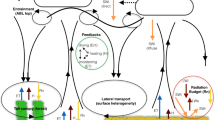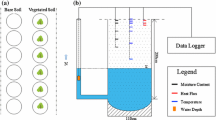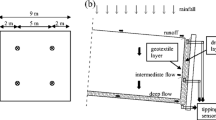Summary
Accurate measurements of thermal conductivity and diffusivity, made both at soil surface by a flat heater and at various depths by cylindrical heat sources, had allowed a better estimation of soil heat flux. It was seen that heat flux is an important component in the energy balance for a bare soil over a short time interval (as 1 hr): indeed, when the driving force of evaporation is active and soil water content is low, heat flux may reach the peak value of 25 percent of net radiation, and, when the evaporative heat is zero, it may reach a value slightly more than 40 percent (generally, this is noted few hours after sunrise or before sunset). Subsequently, the estimate of the evaporative heat by energy balance is more realistic if the value of soil heat flux is not ambiguous, provided that all other components are known or measurable.
Zusammenfassung
Genaue Messungen der thermischen Leitfähigkeit und der Diffusion, die auf der Boden-oberfläche mit einer flachen Heizquelle und in verschiedenen Tiefen mit zylindrischen Wärmequellen durchgeführt worden sind, haben eine bessere Schätzung des Wärmeflusses im Boden ermöglicht. Es wurde festgestellt, daß der Wärmefluß eine wichtige Komponente der Energiebilanz in einem aperen Boden über ein kurzes Zeitintervall hinweg (1 Stunde) ist. Tatsächlich kann, wenn Verdunstung auftritt und der Bodenwassergehalt gering ist, der Wärmefluß einen Spitzenwert von 25% der Strahlungsbilanz erreichen und, wenn die Verdunstungswärme Null ist, kann er einen Wert etwas über 40% erreichen (dies ist im allgemeinen wenige Stunden nach Sonnenaufgang oder vor Sonnenuntergang der Fall). Folglich ist die Schätzung der Verdunstungswärme aus der Energiebilanz mehr realistisch, wenn der Wert des Wärmeflusses in Boden nicht unsicher ist, vorausgesetzt, daß alle anderen Komponenten bekannt oder meßbar sind.
Similar content being viewed by others
References
Aeronautica Militare Italiana: Servizio Meteorologico: Bollettino Meteorologico quotidiano, Roma.
Beck, A. E., Jaeger, J. C., Newstead, G. N.: The Measurement of the Thermal Conductivities of Rocks by Observations in Boreholes. Aust. Jour. Phys.9, 286–296 (1956).
Blanc, M. L.: Measurement of Evaporation, Humidity in the Biosphere and Soil Moisture. W.M.O., No. 72, TP 28, Geneva, 1958.
Campbell, A. P.: The Effect of Stability on Evaporation Rates Measured by the Energy Balance Method. Agr. Met.11, 261–268 (1973).
Ferreira, H. M., Peixoto, J. P.: Evaporation and Evapotranspiration. Geoph. Inst. “Infante D. Luis”, Pub. No. 10, Lisboa, 1970.
Fritschen, L. J.: Accuracy of Evapotranspiration Determinations by the Bowen Ratio Method. J. A. S. H. Bull.10, 38–48 (1965).
Idso, S. B., Jackson, R. D., Reginato, R. J., Kimball, B. A., Nakayama, F. S.: The Dependence of Bare Soil Albedo on Soil Water Content. Jour. Appl. Met.14, 109–113 (1975).
Linacre, E. T.: Net Radiation to Various Surfaces. J. Appl. Ecol.6, 61–75 (1969).
Mongelli, F., Piacente, S., Zito, G.: Radiation Balance and Soil Moisture. Geof. e Met.19, 55–58 (1970).
Mongelli, F., Zito, G., Loddo, M.: A Method for the Determination of the Thermal Properties of Soil Near the Surface. Arch. Met. Geoph. Biokl., Ser. A,20, 35–42 (1971).
Pruitt, W. O.: Diurnal and Seasonal Variations in the Relationship Between Evapotranspiration and Radiation. In: Investigations of Energy and Mass Transfer Near the Ground Including Influences of the Soil-Plant.—Atmospheric System. Univ. of Calif., Davis, Calif., 1962.
Revfeim, K. J. A., Jordan, R. B.: Precision of Evaporation Measurements Using the Bowen Ratio. Boundary-lay. Met.10, 97–111 (1976).
Seginer, I.: Wind Effect on the Evaporation Rate. Jour. Appl. Met.10, 215–220 (1971).
Sellers, W. D.: Physical Climatology. Chicago: University of Chicago Press 1965.
Tanner, C. B.: Energy Balance Approach to Evapotranspiration From Crops. Soil Sci. Soc. Amer. Proc.24, 1–9 (1960).
Tanner, C. B., Pelton, W. L.: Potential Evapotranspiration Estimates by the Approximate Energy Balance Method of Penman. J. Geoph. Res.65, 3391–3412 (1960).
Tanner, C. B., Fuchs, M.: Evaporation From Unsaturated Surfaces: A Generalized Combination Method. J. Geoph. Res.73, 1299–1304 (1967).
Van Bavel, C. H. M., Hillel, D. I.: Calculating Potential and Actual Evaporation From a Bare-Soil Surface by Simulation of Concurrent Flow of Water and Heat. Agr. Met.17, 453–476 (1976).
Zito, G., Loddo, M., Mongelli, F.: Evaluation of the Soil Heat Storage Variations. Geof. e Met.20, 101–104 (1971).
Author information
Authors and Affiliations
Additional information
With 2 Figures
Rights and permissions
About this article
Cite this article
Zito, G., Mongelli, F. & Loddo, M. Influence of accurate heat flux measurements on the evaluation of evaporation from a bare soil by energy balance. Arch. Met. Geoph. Biokl. A. 27, 155–169 (1978). https://doi.org/10.1007/BF02246692
Received:
Issue Date:
DOI: https://doi.org/10.1007/BF02246692




